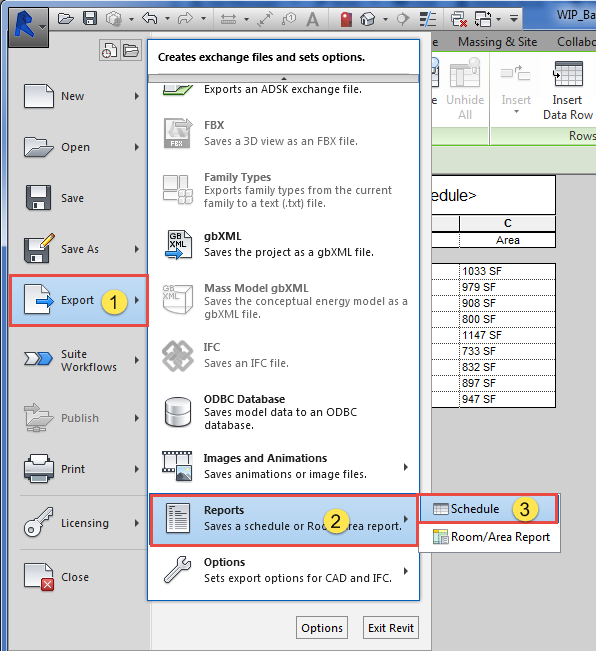
A couple of weeks ago, I was reorganizing all the rooms in my Revit model. The room numbers and departments were shifting around and I needed to update all the rooms to reflect the new organization. I'd been putting this off for a few days. It's not an exciting task but it had to get done so I rolled up my sleeves and got to work.
I find it a lot easier to work in a tabular format for this type of task so I created a room schedule in Revit. Since this was going to be a working schedule and wouldn't appear on a sheet, I set it up to show only the data that was changing.
This method works pretty well. It's a lot faster than clicking each of the room objects in the model. However, I wish schedule views worked better. I wish I could easily copy a value to multiple cells. I wish I could drag a number down and it would increment at each cell. I wish I could add more advanced formulas. Basically, I wish schedules worked more like Excel.
Fortunately, it's easy to link your Revit data to Excel. It's even possible to edit your Revit model directly from Excel. Sounds pretty cool, right?
Working with Excel
I'm a big fan of Excel. I've written a lot about it here on ArchSmarter. I figure in a given week, I probably use Excel almost as much as I use Revit. Given the data-centric nature of BIM, Excel is a great tool for maximizing the value of your BIM data. The trick is getting that data out of the model and into a format you can use.
So what's the easiest way to link Revit and Excel?
4 Ways to Link Revit to Excel
There are four different ways you can link Revit to Excel. The best method depends on the type of data you're working with and what you're ultimately going to do with that data. Some methods are strictly a one-way export. Other methods create a true two-way link between Revit and Excel. With a two-way link, you can edit your model directly from Excel.
Here are the 4 ways you can link Revit to Excel:
1. Export a schedule
The easiest way to get data out of your model is to create a Revit schedule and then export it directly to Excel. This method works great if the data is straightforward and can be captured in a schedule. Things like room schedules and drawing lists are great for this method. Keep in mind that this is a one-way export. There's no link between Revit and Excel so any changes you make in Excel will need to be updated manually in Revit.
To export the data, first make the schedule your active view. Click the Revit button then click the "Export" from the list. Select "Reports" then choose "Schedule".

2. Use an add-in
I've written about Revit add-ins in a previous post. Two good ones for working with Excel are
Ideate BIMLink and Exceler8. Both these options allow you to export data out to Excel and import data. They're not free but both come packed full of features that you'll find essential if you're doing some heavy Revit to Excel work.
3. Write your own macro
If you want to get your hands dirty and write some code, it's fairly easy to write a macro to import and export data to Excel. Jeremy Tammick over at The Builder Coder wrote a great post back in 2012 on writing your own parameter exporter.'
I'm working on a macro version of Jeremy's parameter exporter which I'll make available in the ArchSmarter Toolbox.
4. Create a Dynamo script
Dynamo is a visual programming tool for Revit. Instead of writing code, you use nodes to graphically construct your program (or graph in Dyno-speak). You link the nodes together in the Dynamo editor to create the structure of your graph. Dynamo has full access to the Revit API so it's a good alternative to writing macros or add-ins.
Dynamo comes with Revit so there's no need to install another piece of software. It's accessed from the "Manage" ribbon. You can check out the Dynamo Primer for more information on using Dynamo.
Dynamo is a great tool for what I call the "coder-doer" or the person doing the work who creates the tool to help them do that work. If you need a specific tool to solve a specific problem, you can create a Dynamo graph to get you there. It won't be industrial strength. It probably won't be pretty but you'll get your work done. Here's a view of the graph I created to solve the room problem I mentioned at the beginning of the post.
Want to see how I did this? I put together a video tutorial that walks you through the process of linking Revit room objects to Excel. As you'll see, once I've created the link, I can edit the Revit model directly from Excel.

Here's the video:
Conclusion
Linking Revit to Excel can be as easy or as complex as needed to accomplish your task. If you're willing to get your hands dirty, you can even create your own tool using Dynamo or writing a Revit macro. Once you've created the link, you can really take charge of your Revit data and leverage the power of BIM.
So how are you using Revit and Excel? Do you have any tips or tricks for importing and exporting your data? If so, leave a comment below!
Join ArchSmarter!
Sign up for ArchSmarter updates and get access to the ArchSmarter Toolbox, a collection of time-saving Revit macros, Dynamo scripts, and other resources. Plus you'll get weekly productivity tips, webinar invitations and more! Don't worry, your information will not be shared.
We hate SPAM. We will never sell your information, for any reason.

